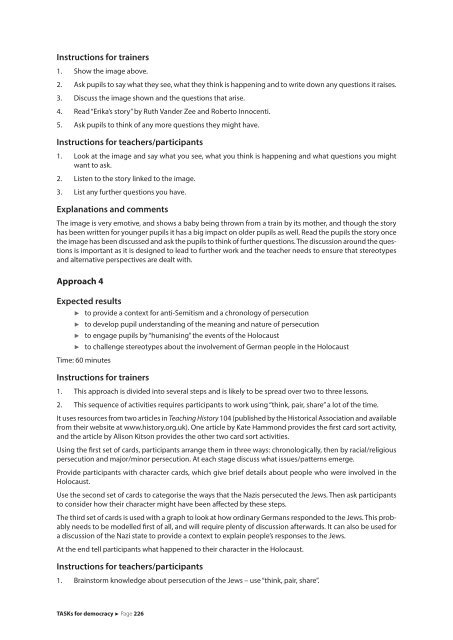TASKs for democracy
4NYw4W
4NYw4W
You also want an ePaper? Increase the reach of your titles
YUMPU automatically turns print PDFs into web optimized ePapers that Google loves.
Instructions <strong>for</strong> trainers<br />
1. Show the image above.<br />
2. Ask pupils to say what they see, what they think is happening and to write down any questions it raises.<br />
3. Discuss the image shown and the questions that arise.<br />
4. Read “Erika’s story” by Ruth Vander Zee and Roberto Innocenti.<br />
5. Ask pupils to think of any more questions they might have.<br />
Instructions <strong>for</strong> teachers/participants<br />
1. Look at the image and say what you see, what you think is happening and what questions you might<br />
want to ask.<br />
2. Listen to the story linked to the image.<br />
3. List any further questions you have.<br />
Explanations and comments<br />
The image is very emotive, and shows a baby being thrown from a train by its mother, and though the story<br />
has been written <strong>for</strong> younger pupils it has a big impact on older pupils as well. Read the pupils the story once<br />
the image has been discussed and ask the pupils to think of further questions. The discussion around the questions<br />
is important as it is designed to lead to further work and the teacher needs to ensure that stereotypes<br />
and alternative perspectives are dealt with.<br />
Approach 4<br />
Expected results<br />
to provide a context <strong>for</strong> anti-Semitism and a chronology of persecution<br />
<br />
<br />
to develop pupil understanding of the meaning and nature of persecution<br />
to engage pupils by “humanising” the events of the Holocaust<br />
to challenge stereotypes about the involvement of German people in the Holocaust<br />
Time: 60 minutes<br />
Instructions <strong>for</strong> trainers<br />
1. This approach is divided into several steps and is likely to be spread over two to three lessons.<br />
2. This sequence of activities requires participants to work using “think, pair, share” a lot of the time.<br />
It uses resources from two articles in Teaching History 104 (published by the Historical Association and available<br />
from their website at www.history.org.uk). One article by Kate Hammond provides the first card sort activity,<br />
and the article by Alison Kitson provides the other two card sort activities.<br />
Using the first set of cards, participants arrange them in three ways: chronologically, then by racial/religious<br />
persecution and major/minor persecution. At each stage discuss what issues/patterns emerge.<br />
Provide participants with character cards, which give brief details about people who were involved in the<br />
Holocaust.<br />
Use the second set of cards to categorise the ways that the Nazis persecuted the Jews. Then ask participants<br />
to consider how their character might have been affected by these steps.<br />
The third set of cards is used with a graph to look at how ordinary Germans responded to the Jews. This probably<br />
needs to be modelled first of all, and will require plenty of discussion afterwards. It can also be used <strong>for</strong><br />
a discussion of the Nazi state to provide a context to explain people’s responses to the Jews.<br />
At the end tell participants what happened to their character in the Holocaust.<br />
Instructions <strong>for</strong> teachers/participants<br />
1. Brainstorm knowledge about persecution of the Jews – use “think, pair, share”.<br />
<strong>TASKs</strong> <strong>for</strong> <strong>democracy</strong> Page 226


